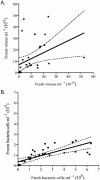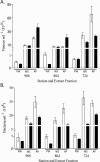Assessment of factors influencing direct enumeration of viruses within estuarine sediments
- PMID: 16820470
- PMCID: PMC1489380
- DOI: 10.1128/AEM.00297-06
Assessment of factors influencing direct enumeration of viruses within estuarine sediments
Abstract
Accurate enumeration of viruses within environmental samples is critical for investigations of the ecological role of viruses and viral infection within microbial communities. This report evaluates differences in viral and bacterial direct counts between estuarine sediment samples which were either immediately processed onboard ship or frozen at -20 degrees C and later processed. Viral and bacterial abundances were recorded at three stations spanning the length of the Chesapeake Bay in April and June 2003 within three sediment fractions: pore water (PW), whole sediment (WS), and sediment after pore water removal (AP). No significant difference in viral abundance was apparent between extracts from fresh or frozen sediments. In contrast, bacterial abundance was significantly lower in the samples subjected to freezing. Both bacterial and viral abundance showed significant differences between sediment fractions (PW, WS, or AP) regardless of the fresh or frozen status. Although pore water viral abundance has been used in the past as a measurement of viral abundance in sediments, this fraction accounted for only ca. 5% of the total sediment viral abundance across all samples. The effect of refrigerated storage of sediment viral extracts was also examined and showed that, within the first 2 h, viral abundance decreased ca. 30% in formalin-fixed extracts and 66% in unfixed extracts. Finally, the reliability of direct viral enumeration via epifluorescence microscopy was tested by using DNase treatment of WS extractions. These tests indicated that a large fraction (>86%) of the small SYBR gold fluorescing particles are likely viruses.
Figures





Similar articles
-
Determination of virus abundance in marine sediments.Appl Environ Microbiol. 2001 Mar;67(3):1384-7. doi: 10.1128/AEM.67.3.1384-1387.2001. Appl Environ Microbiol. 2001. PMID: 11229937 Free PMC article.
-
Flow cytometric analysis of bacteria- and virus-like particles in lake sediments.J Microbiol Methods. 2006 Mar;64(3):316-32. doi: 10.1016/j.mimet.2005.05.008. Epub 2005 Aug 2. J Microbiol Methods. 2006. PMID: 16081175
-
Interannual dynamics of viriobenthos abundance and morphological diversity in Chesapeake Bay sediments.FEMS Microbiol Ecol. 2012 Feb;79(2):474-86. doi: 10.1111/j.1574-6941.2011.01238.x. Epub 2011 Nov 21. FEMS Microbiol Ecol. 2012. PMID: 22092335
-
Abundance and Distribution of Enteric Bacteria and Viruses in Coastal and Estuarine Sediments-a Review.Front Microbiol. 2016 Nov 1;7:1692. doi: 10.3389/fmicb.2016.01692. eCollection 2016. Front Microbiol. 2016. PMID: 27847499 Free PMC article. Review.
-
Detection and quantification of microbial cells in subsurface sediments.Adv Appl Microbiol. 2011;76:79-103. doi: 10.1016/B978-0-12-387048-3.00003-9. Adv Appl Microbiol. 2011. PMID: 21924972 Review.
Cited by
-
An Improved Method for Extracting Viruses From Sediment: Detection of Far More Viruses in the Subseafloor Than Previously Reported.Front Microbiol. 2019 Apr 29;10:878. doi: 10.3389/fmicb.2019.00878. eCollection 2019. Front Microbiol. 2019. PMID: 31110497 Free PMC article.
-
Impacts of poultry house environment on poultry litter bacterial community composition.PLoS One. 2011;6(9):e24785. doi: 10.1371/journal.pone.0024785. Epub 2011 Sep 16. PLoS One. 2011. PMID: 21949751 Free PMC article.
-
Seasonal dynamics and metagenomic characterization of estuarine viriobenthos assemblages by randomly amplified polymorphic DNA PCR.Appl Environ Microbiol. 2009 Apr;75(8):2259-65. doi: 10.1128/AEM.02551-08. Epub 2009 Feb 13. Appl Environ Microbiol. 2009. PMID: 19218408 Free PMC article.
-
Virioplankton dynamics are related to eutrophication levels in a tropical urbanized bay.PLoS One. 2017 Mar 31;12(3):e0174653. doi: 10.1371/journal.pone.0174653. eCollection 2017. PLoS One. 2017. PMID: 28362842 Free PMC article.
-
An Advanced Protocol for the Quantification of Marine Sediment Viruses via Flow Cytometry.Viruses. 2021 Jan 13;13(1):102. doi: 10.3390/v13010102. Viruses. 2021. PMID: 33451082 Free PMC article.
References
-
- Bales, R. C., S. M. Li, K. M. Maguire, M. T. Yahya, and C. P. Gerba. 1993. Ms-2 and poliovirus transport in porous media: hydrophobic effects and chemical perturbations. Water Resources Res. 29:957-963.
-
- Bales, R. C., S. M. Li, K. M. Maguire, M. T. Yahya, C. P. Gerba, and R. W. Harvey. 1995. Virus and bacteria transport in a sandy aquifer, Cape-Cod, MA. Ground Water 33:653-661.
-
- Beiras, R., E. His, and M. N. L. Seaman. 1998. Effects of storage temperature and duration on toxicity of sediments assessed by Crassostrea gigas oyster embryo bioassay. Environ. Toxicol. Chem. 17:2100-2105.
-
- Bettarel, Y., T. Sime-Ngando, C. Amblard, J. F. Carrias, and C. Portelli. 2003. Virioplankton and microbial communities in aquatic systems: a seasonal study in two lakes of differing trophy. Freshwat. Biol. 48:810-822.
Publication types
MeSH terms
LinkOut - more resources
Full Text Sources
Miscellaneous

